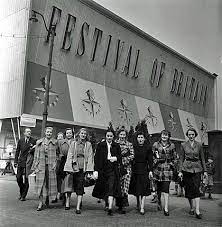 The Festival of Britain was a national exhibition and fair that reached millions of visitors throughout the UK in the summer of 1951. Six years after the end of the Second World War, and exactly one hundred years since the famous Great Exhibition of 1851 – the first international exhibition of manufactured products – the Festival of Britain was a display showcasing the best of British manufacturing and design. Rather than staging another World Fair, it became a celebration of peace and modernity, with its champion being Herbert Morris, Labour politician and former leader of the London County Council.
The Festival of Britain was a national exhibition and fair that reached millions of visitors throughout the UK in the summer of 1951. Six years after the end of the Second World War, and exactly one hundred years since the famous Great Exhibition of 1851 – the first international exhibition of manufactured products – the Festival of Britain was a display showcasing the best of British manufacturing and design. Rather than staging another World Fair, it became a celebration of peace and modernity, with its champion being Herbert Morris, Labour politician and former leader of the London County Council.
The Festival became a “beacon for change” that proved immensely popular and helped re-shape British arts, crafts, designs and sports for a generation. It celebrated Britain’s contribution to civilization – past, present and future.
Intended as a tonic for the nation, the Festival of Britain was a spectacular cultural event to raise the spirits of a country still in the grasp of austerity and rationing, and undergoing severe social and economic reform. Importantly, it also acted as a catalyst for a new design aesthetic, launching the career of noted British designers working in the fields of textiles, furniture and graphic design.
Opening on 4 May 1951 the Festival of Britain was a nationwide event. The Festival’s centrepiece was the South Bank Exhibition which demonstrated the contribution made by British advances in science, technology and industrial design, displayed against a background representing the living, working world of the day. There were events in many locations including in Poplar (Architecture), Belfast held the Farm and Factories exhibition. Glasgow’s Kelvingrove hosted the Industrial Power exhibition. A festival ship, HMS Compania, visited ten United Kingdom ports.
 The Pleasure Gardens in Battersea (to the West of the main site) – offered fairground rides and fun rather than cultural edification and was the one commercially sponsored area of the Festival. Beer maker Guinness entertained the crowds with its hugely popular Guinness Festival Clock, a 25-foot-high mechanical clock with a display of characters from Guinness advertising, as well as a zookeeper and the Mad Hatter. There were also touring exhibitions by land and sea.
The Pleasure Gardens in Battersea (to the West of the main site) – offered fairground rides and fun rather than cultural edification and was the one commercially sponsored area of the Festival. Beer maker Guinness entertained the crowds with its hugely popular Guinness Festival Clock, a 25-foot-high mechanical clock with a display of characters from Guinness advertising, as well as a zookeeper and the Mad Hatter. There were also touring exhibitions by land and sea.
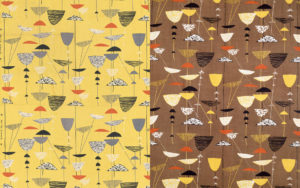 Progressive textiles
Progressive textiles
Lucienne Day’s radically new and elaborate wallpaper and fabric designs were also showcased at the Festival, in the Homes and Gardens Pavilion. Her most celebrated textile design, Calyx, with its abstract plant motif, was a striking departure from the typical floral prints that were commercially available at the time.
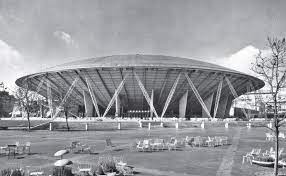
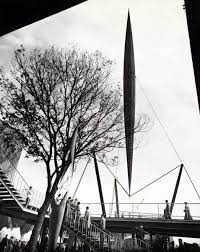
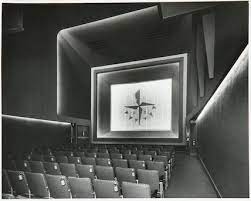
Futuristic architecture and furniture
Several unique temporary buildings were constructed for the event, including the Dome of Discovery, the largest dome in the world at the time, which housed exhibitions ranging from the physical world to outer space; the Skylon, a futuristic tower that ‘floated’ on cables; the Telekinema, a state-of-the-art cinema; and Royal Festival Hall. Such sculptural structures required unique seating. Due to wood being rationed, furniture designs needed to find ways to incorporate alternative materials, like aluminium or steel.
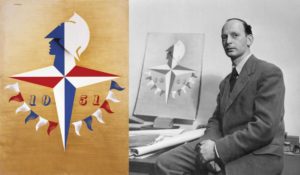
Powerful posters
Abram Games [please see event on 18/5/21 listed below] created many of the striking posters used throughout the Festival. He began his career designing impactful public information posters for the War Office. His designs incorporating heraldic imagery and angular geometry to create a modern portrait of the national character featured on posters, leaflets, souvenirs and catalogues, helping to create what would become known as ‘Festival Style’.
Talk by the daughter of the poster designer, Abram Games
On the 70th anniversary of the Festival of Britain, Naomi Games will give an illustrated talk about her father Abram Games’ design for the festival. Abram won the competition to design a symbol for the ‘Tonic to the Nation’ and the festival stamp. Naomi will give a personal view of her father’s working process, you will see his progressive designs, other items he created for the festival, as well as cartoons and curiosities.
Key talking points will include a brief description of the birth of the festival, the designs from the festival symbol and stamp competition, Games’ designs, associated posters, murals and souvenirs, as well as current adaptations of the festival symbol.
Tickets for Zoom event at the Museum of Brands on 18 May
https://www.artfund.org/whats-on/events/2021/05/18/abram-games-design-of-the-festival-of-britain
